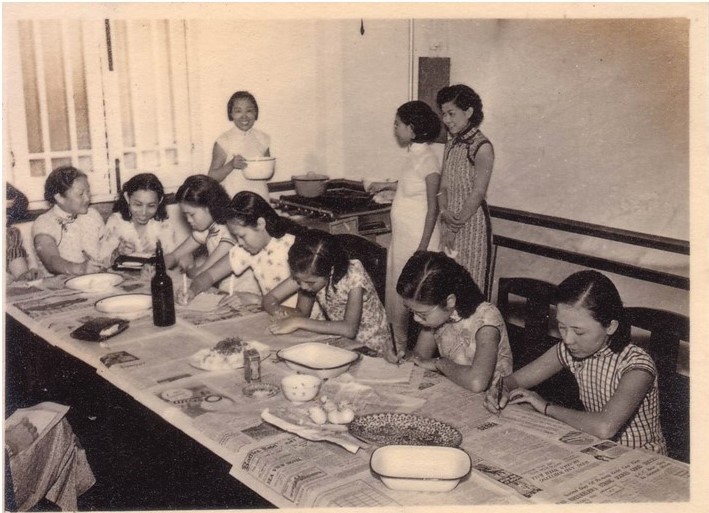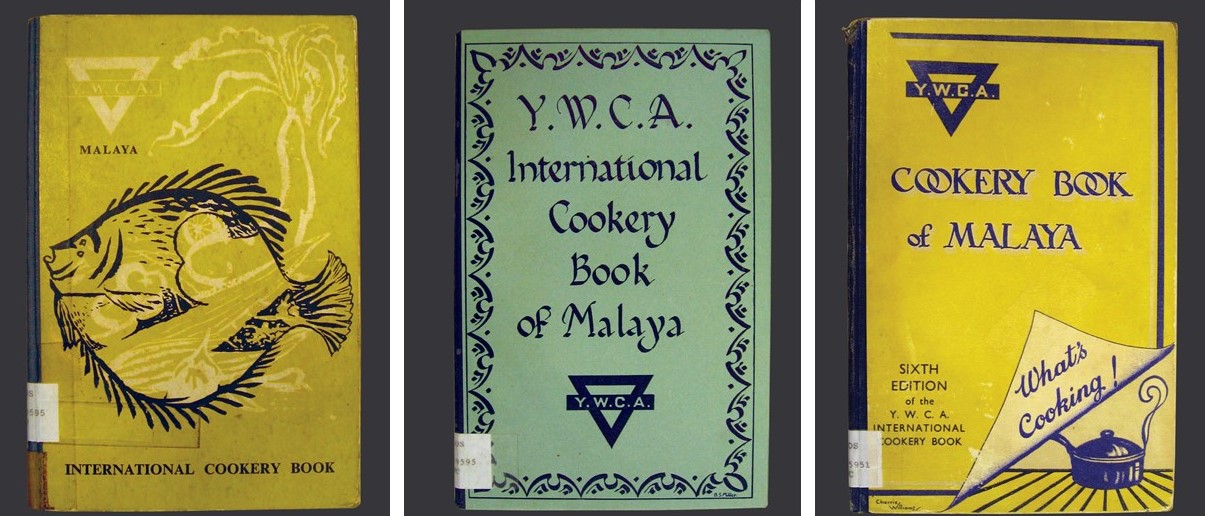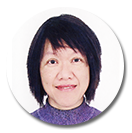In Cookery We Trust: The YWCA Cookery Book (1932–1964)
The Y.W.C.A. Cookery Book of Malaya is a treatise on the changing culinary styles as well as evolving domestic practices and eating habits of Singaporeans over three decades.

“I value my copy [of the Y.W.C.A. Cookery Book of Malaya] as a social study of living conditions in Asia, quite apart from its practical kitchen uses.” — Julie Pritchard1
First published in 1932, the Y.W.C.A. Cookery Book of Malaya has been updated and republished nine times – the last in 1962. More than an ordinary record of recipes, this influential cookbook is a treatise on the changing culinary styles as well as evolving domestic practices and eating habits of Singaporeans over three decades.
The Young Women’s Christian Association (YWCA) was founded in 1855 during the Industrial Revolution in England. Exactly 20 years later in Singapore, a young missionary named Sophia Cooke gathered a group of young Chinese ladies from the school she founded2 and formed a branch of the YWCA.3 Her vision of these members – “trusting in God and of helping themselves without forgetting others”4 – remains a vital guiding principle of the YWCA today.
Cookery Classes
In the early 19th century, cooking classes became a central activity in the YWCA in Singapore, following a new understanding in Britain of nutritional needs and a push towards training women to prepare balanced yet tasty meals.5 Initially, only lessons in preparing Western meals6 were offered, but by the 1920s local dishes were common fare.7 In 1933, YWCA members conducted a series of cookery demonstrations at the Kuala Lumpur Electrical department showrooms. These were believed to be the first public cookery demonstrations organised in Malaya, and the daily morning course attracted more than a hundred participants.
Participants were exposed to dishes beyond those they were familiar with, whether British or Malayan, and included meals from India and the United States.8 In these classes, expatriate ladies were introduced to Asian flavours and cooking styles, while Malayan women learned techniques of Western cooking and concepts of good nutrition.9 More than an exchange of ideas, these classes became a nurturing environment where Malayan women could fraternise with the wives of British colonials and American missionaries.10 It was also a place where local women began to take centre stage as cooking instructors, first for local dishes and later in teaching the various cuisines that Singaporeans are now so familiar with.
The YWCA Cookbook
At the YWCA Malayan Conference in Ipoh in 1931, the publication of a cookery book was mooted in a bid to preserve the numerous recipes taught at the YWCA’s cookery classes throughout Malaya. One thousand copies of The Y.W.C.A. Cookery Book of Malaya were printed in 1932. These flew off the shelves so quickly that a reprint was commissioned the following year. In 1935, an expanded and “very considerably altered”11 second edition was released. This new edition distinguished itself from earlier cookery books as it went beyond listing recipes and instructing new expatriate wives on how to deal with local cooks.
Furtado, who contributed an article to The Y.W.C.A. Cookery Book, noted that “[t]he few books that deal with Asiatic cooking limit themselves to giving recipes for this or that dish, without explaining anything about the principles involved, or the effects of the various ingredients used”.12 This new cookbook was revolutionary in the sense that it introduced articles on the nutritional value of food13 and shared practical tips, many written by experts in their fields. For example, R.E. Holttum, who was then Director of the Botanic Gardens, contributed a useful article on the cultivation of salad vegetables,14 while W. Birtwistle, who was the officer in charge of fisheries, described an extensive number of local fish in an article accompanied by clear line drawings.15 Additionally, Holttum’s market list provides the local names of ingredients, while Furtado’s general notes on Indo-Malayan cookery explain the key Malayan terms for food items. The cookbook also addressed a growing interest in nutrition, hygienic food preparation and specialised recipes, such as those for children.
Local dishes were first included in the second edition, and the editors drew from the expertise of Chinese and Indian contributors for their recipes. Many were wives of Christian men of influence, while others had conducted cooking classes at the YWCA.16 The editors also sought insights from doctors and nurses for the sections devoted to the nutritional needs of invalids and children. This edition drew its arrangement of recipes and its “clear description of cookery principles” from Mrs Lucas’s French Cookery Book, which was published in 1929.17
The Cookbook Editors
The editors of the second edition of the cookbook were Ursula Holttum and Gertrude Hinch (the wives of R.E. Holttum and T.W. Hinch respectively). Their contributions to the community are an indication of how the lives of these expatriate and local women were intertwined. Both editors were active in the YWCA committee where Ursula served as treasurer and Gertrude as Malaya’s representative for the International YWCA.
Cooking for these women was not merely a leisurely or educational pastime; it was essential for survival during the Pacific War. In 1941, as meat became scarce, Ursula published a booklet titled How to Cook Malayan Vegetables. The book launch was accompanied by several radio talk shows18 where she gave instructions on the cooking of local vegetables that many European housewives were unfamiliar with. Her knowledge complemented her husband’s article on the growing of salad vegetables in the 1935 edition of The Y.W.C.A. Cookery Book. Holttum shared Ursula’s conviction that eating right would help reduce the negative effects of a poor diet, especially in those dark times.19
 These cookbooks reflect the changes in domestic science and social norms among women in pre- and postwar Malaya.
These cookbooks reflect the changes in domestic science and social norms among women in pre- and postwar Malaya.
The fifth edition of The Y.W.C.A. International Cookery Book of Malaya – fondly known as the “Blue Triangle Cookery Book”20 by the Association’s cookery class students – was released in 1948, this time under the editorship of Morag Llewellyn. Armed with a diploma in domestic science from the University of London,21 Morag arrived with her husband, Alun Ewart Llewellyn, in Malaya in 1934. Alun managed collieries in Malaya until they left the region for good in 1966, by which time Morag had overseen the updating and republishing of the cookbook five more times into its ninth edition in 1962.22
Postwar Food and Cooking
The fifth edition of the cookbook coincided with the postwar period from 1945 onwards. After the Japanese surrender in Singapore, the British returned to a situation plagued by high unemployment, unrest and chronic food shortages. Food rationing during this period led to innovations such as the use of coconut cream as a milk substitute and gula melaka23 (palm sugar) in place of refined white sugar to flavour food. As a result, recipes for local cakes and sweets as well as dishes using coconut milk made their way into The Y.W.C.A. Cookery Book during this period.
Recipes of local sweets such as kueh pisang (steamed banana cakes), kueh koya (baked green-bean cookies) and spiku (a Malay layered cake) were featured. The book also had a new section titled “Javanese recipes” with recipes for curries and sambals that incorporated local spices and products from the ever-useful coconut. Interestingly, the section “Vegetarian Cookery” by T. H. Silcock, first written in 1939, was reduced because some ingredients were not available soon after the war.24
The fifth edition also included many more articles on food preparation to meet the urgent need for “culinary and nutritional information” in postwar Malaya. These included steps in identifying and cooking vegetables, storing and cooking rice, and preparing and cooking fish and meats.25 A practical section on planning meals and making a timetable was followed by different methods of cooking described in English and translated into Malay by Dato Seciawangsa Mahmud bin Mat.
Large sections of the book remained unchanged for the next four editions, with only “a few alterations appropriate to the present affluent conditions in Malaya”.26 What changed considerably, however, was the book’s standing: By the 1960s, the publication had found its way beyond Malaya “having been taken there or sent as gifts by people living in Malaya”.27 It was no longer just an important reference for homemakers but had become a textbook for domestic science classes in Singapore and the Federation of Malaya.
Morag, the five-time editor of the cookbook, had wanted to improve the 1962 edition with more information on Malayan fruits, include vegetarian recipes from the Buddhist community and rework the glossary of Malay names.28 Unfortunately, she never succeeded in publishing the 10th edition as her husband was diagnosed with cancer and the family left for England in 1966.
As a publication spanning the pre- and postwar periods of Malaya’s development, the various editions of The Y.W.C.A. International Cookery Book of Malaya mirror the changes in domestic science and the evolution of social norms among the women of Malaya during these tumultuous times. This collection of cookbooks, held in the National Library of Singapore, contains a wealth of information for researchers wanting to learn more about the domestic culinary habits of Malayan households and the lifestyles of women, both local and foreign, between 1932 and 1964.
 Bonny Tan is a Senior Librarian who has served at the Reference Library at the National Library Board since 1997. Her passion for Singapore food has increased since she telecommutes from Vietnam, where she is currently based.
Bonny Tan is a Senior Librarian who has served at the Reference Library at the National Library Board since 1997. Her passion for Singapore food has increased since she telecommutes from Vietnam, where she is currently based.REFERENCES
C.G.’s wife learns Chinese cooking. (1949, May 23). The Straits Times, p. 5. Retrieved from NewspaperSG.
Cookery classes for Kuala Lumpur. (1936, February 13). The Straits Times, p. 4. Retrieved from NewspaperSG.
Feminine notes. (1908, November 25). The Straits Times, p. 10. Retrieved from NewspaperSG.
Glendinning, A. (2000). Civilian internees of the Japanese in Singapore during WWII. Asian Pages. Retrieved from Asian Pages website.
Holttum, R.E., & Hinch, T.W. (1935–1937). International cookery book of Malaya. Malaya: YWCA of Malaya. (Call no.: RRARE 641.59595 YOU; Microfilm nos.: NL16675, NL29320)
Holttum, R.E., & Waite, D.S. (1939). The Y.W.C.A. International cookery book of Malaya. Singapore: Malayan Committee of the Y.W.C.A. (Call no.: RRARE 641.59595 YWC)
Women of Far East. (1928, December 17). The Singapore Free Press and Mercantile Advertiser, p. 13. Retrieved from NewspaperSG.
How to cook some Malayan vegetables. (1941, January 30). The Singapore Free Press and Mercantile Advertiser, p. 5. Retrieved from NewspaperSG.
Learn to be a cook of many dishes. (1939, August 24). The Straits Times, p. 5. Retrieved from NewspaperSG.
Llewellyn, A.E. (Ed.). (1948). The Y.W.C.A. International cookery book of Malaya. Singapore: Malayan Committee of the Y.W.C.A. (Call no.: RCLOS 641.59595 YWC)
Llewellyn, A.E. (Ed.). (1951). The Y.W.C.A. of Malaya & Singapore cookery book: A book of culinary information and recipes compiled in Malaya. [S.I.]: Y.W.C.A. of Malaya. (Call no.: RCLOS 641.59595 YWC)
Llewellyn, A.E. (Ed.). (1962). The Y.W.C.A. of Malaya cookery book; a book of culinary information and recipes compiled in Malaya. [Kuala Lumpur?] Persatuan Wanita Keristian di Malaya, Y.W.C.A. of Malaya. (Call no.: RCLOS 641.59595 YOU)
Malayan Volunteers Group. (2019). Malayan Volunteers. Retrieved from Malayan Volunteers Group website.
New Y.W.C.A. book on Malayan dishes. (1948, July 7). The Straits Times, p. 5. Retrieved from NewspaperSG.
Pritchardt, J. (1948, July 22). Vitamins, Mullagtany and Malay dishes. The Straits Times, p. 9. Retrieved from NewspaperSG.
Richard Eric Holttum 1895–1990. (2002). In H.R. Halter, (Ed.), The school on the hill: Memories of three hundred years of Friends’ School, Saffron Walden, 1702–2002. Essex: Friends’ School. (Not available in NLB holdings)
Sng, B.E.K. (2003). In his good time: The story of the church in Singapore, 1819–2002. Singapore: Bible Society of Singapore: Graduates’ Christian Fellowship (Call no.: RSING 280.4095957 SNG)
Tan, J., & Low, J. (Eds.). (2007). Sharing from our hearts. Singapore: Young Women’s Christian Association. (Call no.: RSING 641.595957 SHA)
The Chinese Girls’ School. (1899, April 14). The Straits Times, p. 2. Retrieved from NewspaperSG.
Town and country in Malaya. (1933, July 1). The Straits Times, p. 12. Retrieved from NewspaperSG.
Untitled. (1918, March 7). The Straits Times, p. 6. Retrieved from NewspaperSG.
Untitled. (1926, March 25). The Straits Times, p. 9. Retrieved from NewspaperSG.
Wong, H.S. (2009). Wartime kitchen: Food and eating in Singapore, 1942–1950. Singapore: Editions Didier Millet and National Museum of Singapore. (Call no.: RSING 641.30095957 WON)
World Y.W.C.A. (2010–2011). Our history. Retrieved from World Y.W.C.A.org website.
Young Women’s Association. (1898, January 3). The Straits Times, p. 3. Retrieved from NewspaperSG.
Young Women’s Christian Association of Singapore. (1969). Young Women’s Christian Association: YWCA [Ephemera]. Singapore: Young Women’s Christian Association. (Call no.: RCLOS 0404)
Young Women’s Christian Association: 1875–1995. (1995). Singapore: Young Women’s Christian Association. (Call no.: RSING 267.59597 YOU)
NOTES
-
Pritchardt, J. (1948, July 22). Vitamins, Mullagtany and Malay dishes. The Straits Times, p. 9. Retrieved from NewspaperSG. ↩
-
The school is known today as St Margaret’s School. ↩
-
The YWCA of the Straits Settlements and the Federated Malay States initially had its headquarters in Singapore, but this seemed to have moved to Kuala Lumpur after the 1920s. Women of Far East. (1928, December 17). The Singapore Free Press and Mercantile Advertiser, p. 13. Retrieved from NewspaperSG. ↩
-
Young Women’s Christian Association of Singapore. (1969). Young Women’s Christian Association: YWCA (p. 17). [Ephemera]. Singapore: Young Women’s Christian Association. (Call no.: RCLOS 0404) ↩
-
Feminine notes. (1908, November 25). The Straits Times, p. 10. Retrieved from NewspaperSG. ↩
-
For example a notice for the fourth cookery class at the YWCCA indicates that classes were for “pastry making from lard, snow pie, pineapple soufflé, potato and tomato savoury, butter-cheese cakes, banana cheese cakes, duchess cakes. Untitled. (1918, March 7). The Straits Times, p. 6. Retrieved from NewspaperSG. ↩
-
Untitled. (1926, March 25). The Straits Times, p. 9. Retrieved from NewspaperSG. ↩
-
The preface to the 1935 edition of the cookbook notes that “American friends have contributed largely with recipes which they find acceptable and usable in this country”. ↩
-
Though how ‘ordinary’ these women were needs to be studied further as many of the Asian women who attended were likely the English-educated Straits Chinese nyonyas from presumably well-to-do families. ↩
-
C.G.’s wife learns Chinese cooking. (1949, May 23). The Straits Times, p. 5. Retrieved from NewspaperSG. ↩
-
The preface. (1935). In R.E. Holttum & T.W. Hinch, International cookery book of Malaya. Malaya: YWCA of Malaya. (Call no.: RRARE 641.59595 YOU; Microfilm nos.: NL16675, NL29320) ↩
-
Holttum & Hinch, 1935, the preface. ↩
-
Holttum & Hinch, 1935, the preface; This was written by J.L. Rosedale, then Professor of Biochemistry, King Edward VII College of Medicine, Singapore. ↩
-
Holttum & Hinch, 1935, the preface. ↩
-
Holttum & Hinch, 1935, the preface. ↩
-
As almost every recipe credits its author, it is apparent they included the likes of respected expatriates such as Rose T. Handy, Mrs Celeste B. Amstutz, Mrs Eklund, Mrs Zehnder and locals such as Muhammad Raza, Cheka Davies, Mrs Loh Hung Loong and Mrs C.H. Wang. ↩
-
Lucas, E. (1929). Mrs Lucas’s French cookery book. London: Christopher’s (Not available in NLB holdings) ↩
-
The booklet was published by the Department of Information and Publicity. Radio talk on how to cook local vegetables. (1941, April 3). The Straits Times, p. 10. Retrieved from NewspaperSG. ↩
-
Richard Eric Holttum 1895–1990. (2002). In H.R. Halter, (Ed.), The school on the hill: Memories of three hundred years of Friends’ School, Saffron Walden, 1702–2002. Essex: Friends’ School. (Not available in NLB holdings) ↩
-
The “Blue Triangle” is a reference to the YWCA logo that is prominent on the cover of each edition of the book. ↩
-
Cookery classes for Kuala Lumpur. (1936, February 13). The Straits Times, p. 4. Retrieved from NewspaperSG. ↩
-
It is uncertain when the last edition of this publication was printed. The latest copy in the library’s holding is the 1963 edition which was published in 1964. ↩
-
Wong, H.S. (2009). Wartime kitchen: Food and eating in Singapore, 1942–1950 (pp. 65, 68, 88, 89). Singapore: Editions Didier Millet and National Museum of Singapore. (Call no.: RSING 641.30095957 WON) ↩
-
Llewellyn, A.E. (1948). The Y.W.C.A. International cookery book of Malaya. Singapore: Malayan Committee of the Y.W.C.A. (Call no.: RCLOS 641.59595 YWC) ↩
-
Llewellyn, A.E. (1951). The Y.W.C.A. of Malaya & Singapore cookery book: A book of culinary information and recipes compiled in Malaya. [S.I.]: Y.W.C.A. of Malaya. (Call no.: RCLOS 641.59595 YWC) ↩
-
Llewellyn, A.E. (Ed.). (1962). The Y.W.C.A. of Malaya cookery book; a book of culinary information and recipes compiled in Malaya. [Kuala Lumpur?] Persatuan Wanita Keristian di Malaya, Y.W.C.A. of Malaya. (Call no.: RCLOS 641.59595 YOU) ↩

